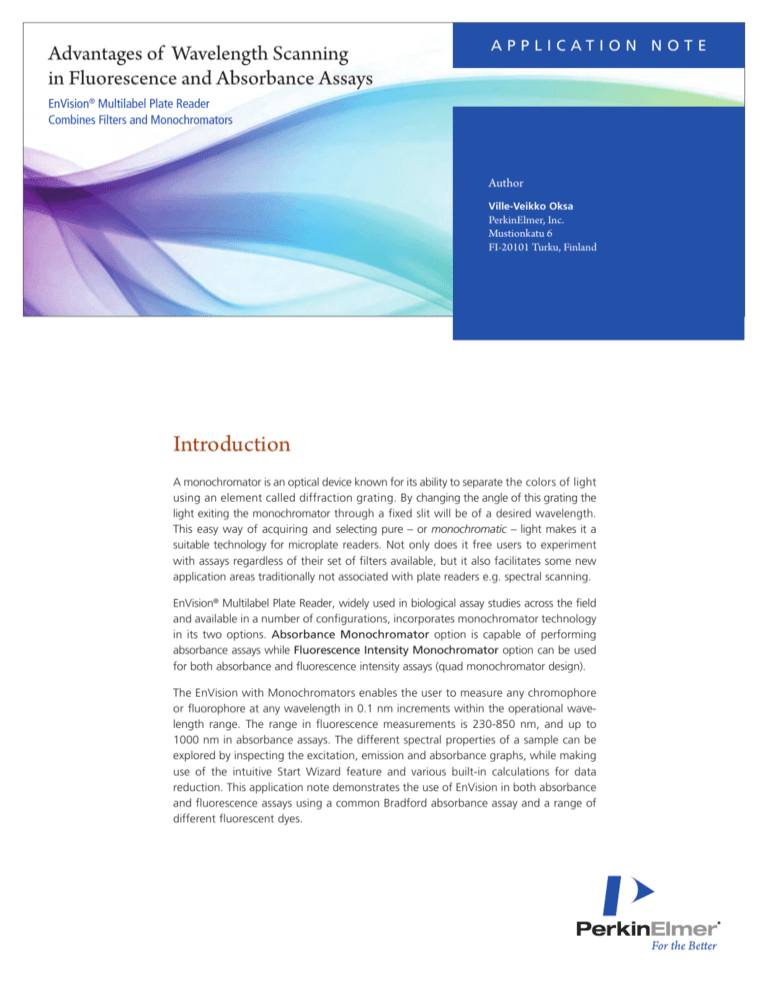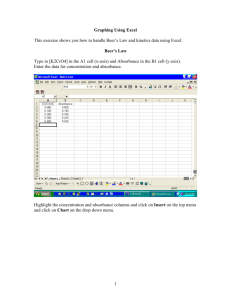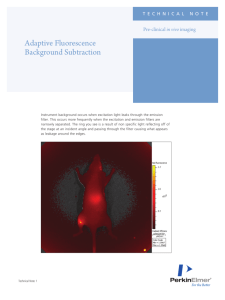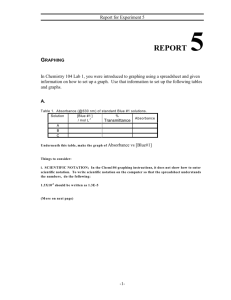
Advantages of Wavelength Scanning
in Fluorescence and Absorbance Assays
a p p l i c at i o n N o t e
EnVision® Multilabel Plate Reader
Combines Filters and Monochromators
Author
Ville-Veikko Oksa
PerkinElmer, Inc.
Mustionkatu 6
FI-20101 Turku, Finland
Introduction
A monochromator is an optical device known for its ability to separate the colors of light
using an element called diffraction grating. By changing the angle of this grating the
light exiting the monochromator through a fixed slit will be of a desired wavelength.
This easy way of acquiring and selecting pure – or monochromatic – light makes it a
suitable technology for microplate readers. Not only does it free users to experiment
with assays regardless of their set of filters available, but it also facilitates some new
application areas traditionally not associated with plate readers e.g. spectral scanning.
EnVision® Multilabel Plate Reader, widely used in biological assay studies across the field
and available in a number of configurations, incorporates monochromator technology
in its two options. Absorbance Monochromator option is capable of performing
absorbance assays while Fluorescence Intensity Monochromator option can be used
for both absorbance and fluorescence intensity assays (quad monochromator design).
The EnVision with Monochromators enables the user to measure any chromophore
or fluorophore at any wavelength in 0.1 nm increments within the operational wavelength range. The range in fluorescence measurements is 230-850 nm, and up to
1000 nm in absorbance assays. The different spectral properties of a sample can be
explored by inspecting the excitation, emission and absorbance graphs, while making
use of the intuitive Start Wizard feature and various built-in calculations for data
reduction. This application note demonstrates the use of EnVision in both absorbance
and fluorescence assays using a common Bradford absorbance assay and a range of
different fluorescent dyes.
Materials and Methods
Absorbance assays
Bovine serum albumin (BSA, #A6003, Sigma) was dissolved in
water to 2 mg/ml and a dilution series was prepared following
Bio-Rad’s standard microplate procedure (0-1500 µg/ml,
3 replicates). Protein Assay Dye (#500-0006, Bio-Rad) concentrate
was prepared according to manufacturer’s instructions for 1x Dye
reagent. Assay was performed in clear 96-well SpectraPlate
MB (#6005279, PerkinElmer). The 1x Dye Reagent was added
to wells with protein dilutions and the plate read with EnVision
Multilabel Plate Reader (model 2104, PerkinElmer) equipped
with Fluorescent Intensity Monochromator option. The instrument
protocol, with shake (30 s) and delay (5 min) operations was set
before reading absorbance at 595 nm using both a filter and
monochromator–based measurements. The plate map was
defined with standard and blank sample types for standard curve
fitting calculation (Fig. 1, Table 1). The Absorbance Wavelength
scan protocol was performed for BSA standard samples (Fig. 2,
Table 1) with a baseline correction prior the scan measurement.
All data were analyzed with EnVision Manager (PerkinElmer) or
GraphPad Prism® (GraphPad Software Inc.).
Figure 1. Protocol structure and plate map. Plate is read with both filters and
monochromators sequentially. The plate map defines the standard dilutions and
their replicates (STD, red), blank samples (BL, yellow) and unknown concentration samples (UNK, light green).
Table 1. Overview of the Assay-Related Settings in EnVision
Exc.
Em.
Step
Flash no.
Operations
Calculations
Absorbance scan
300 – 800 nm
—
1 nm
180
Shake: 30 s, 300 rpm,
ø 0.3 mm, double
orbital, inside
Curve fitting
(blank corrected, std’s
on first plate only)
Mono meas.
595 nm
—
—
180
Delay: 300 s
Fitting: LinReg
Filter meas.
595/10 nm
—
—
10
BSA assay
Fluorescein assay
Excitation scan
Emission scan
400 – 550 nm
575 nm
0.5 nm
500
425 nm
450 – 600 nm
0.5 nm
500
GFP assay
rGFP
Excitation scan
Emission scan
300 – 530 nm
545 nm
1 nm
500
425 nm
450 – 600 nm
1 nm
500
300 – 550 nm
565 nm
1 nm
500
440 nm
460 – 600 nm
1 nm
500
EGFP
Excitation scan
Emission scan
Quantum dot assay
Absorbance scan
Emission scan
2
300 – 700 nm
—
1 nm
100
300 nm
500 – 800 nm
1 nm
100
Figure 2. EnVision Manager settings for running a Wavelength Scan operation.
The scan range and step size are entered in nanometres to the protocol. A
baseline is required to be run through Wizard for absorbance wavelength scans.
Fluorescence Assays
Fluorescein excitation and emission spectra were determined by
using 50 µl of 100 nM Fluorescein standard solution (#C557-100,
PerkinElmer) in black 384-well OptiPlate (#6007279, PerkinElmer).
Both excitation and emission wavelength scans (Table 1)
were read with EnVision and cuvette-based LS 55 spectrometer
(PerkinElmer). Recombinant wild-type GFP (rGFP, #8360-2,
Clontech) and enhanced GFP (rEGFP, #8365-1, Clontech)
were both diluted to 10 µg/ml. GFP samples (200 µl) were
read for spectral properties (Table 1) with EnVision in black
96-well OptiPlate (#6005279, PerkinElmer). Qdot ® 655
(#Q10151MP, Invitrogen) was diluted to 25 µM, absorbance
(with baseline correction) and emission wavelength scan (Table 1)
read in EnVision using 96-well UV-Star® plate (#655801,
Greiner) and black 96-well OptiPlate, respectively (200 µl).
Figure 3. Changes in Coomassie® dye’s absorbance properties. Several absorbance
spectra overlaid as seen in the EnVision Manager software. Illustrated here are the
BSA sample dilutions and their different absorbance properties.
Results
The absorbance spectrum of Bradford reagent is shifted as
the BSA protein binds to Coomassie® (Imperial Chemical
Industries, Ltd.) Brilliant Blue G-250 dye in increasing concentration. After overlaying the graphs from BSA standard
wells, the shift in the absorbance can be seen in relation to
the wavelength as the BSA concentration changes (Fig. 3).
Binding to the BSA causes the Coomassie dye to shift its
absorbance maximum from 465 to 595 nm. Also two isosbestic points can be defined at around 336 nm and 530 nm
where the absorbance is equal irrespective of the BSA concentration. The baseline was recorded against a blank sample for the full absorbance range (230-1000 nm). This effectively corrects the absorbance values for drift that otherwise
would occur during the scan due to the properties in light
output of the Xenon flash lamp.
Figure 4. BSA standard concentration plot. The monochromator and filter measurement resulted in equal absorbance levels. The linear range of the assay for BSA is
exceeded at 0.9 mg/ml, as seen from the linear fit. The Wallac EnVision Manager
software can be used to exclude outliers and perform blank correction to the graph
(data not shown).
The actual absorbance results were observed by comparing
two standard sample plots, one measured with 595/10 nm
photometric filter and other with monochromator set at 595 nm.
The identical range and values outline the equal performance
of monochromator option in absorbance assays (Fig. 4).
The excitation and emission spectra for fluorescein were
compared against the results obtained with a reference
instrument, LS 55 Fluorescence Spectrometer. The acquired
spectral profiles and peak wavelengths are well aligned with
a peak excitation at 490 nm and emission at 513 nm (Fig. 5).
Figure 5. Fluorescein excitation and emission spectra as measured with EnVision
and LS 55.
3
Green fluorescent protein (GFP) variants were examined for their
differences in excitation and emission spectra. The two GFP variants
show distinct differences in their excitation spectra while the
emission properties are identical (Fig.6). The GFP in its wild-type
form (rGFP) shows an excitation maximum at ~395 nm. The
red-shifted form, EGFP, has its corresponding peak at ~485 nm
increasing its excitation coefficient when used e.g. in confocal
microscopy equipped with Argon-ion laser excitation (488 nm).
The absorbance and emission spectra for Qdot® 655 were determined using the EnVision Fluorescence Monochromator option
in both absorbance and FI modes (Fig. 7). EnVision produced
spectral data which also matches the reference absorbance and
emission profiles (data not shown).
Conclusions
Figure 6. rGFP and rEGFP spectra. Two Aequorea victoria GFP variants were
examined for their different excitation maxima. The excitation peak of EGFP is
red-shifted to 485 nm, while the emission spectra maintains the same wavelength
properties.
EnVision is a flexible multilabel plate reader that can be used in
both HTS and basic research applications. The Monochromator
option expands the range of applications as it complements the
suite of filters available. It will also help users to design assays
for sensitive and fast filter-based measurements, perform spectral
scanning and other more robust assays most suitable for a
Monochromator-based system. The data presented here outlines
the accuracy and usefulness of the Monochromator when applied
to fluorescence and absorbance applications.
Figure 7. Absorbance and emission spectra for Qdot® 655 as measured with
EnVision Fluorescence Monochromator option.
PerkinElmer, Inc.
940 Winter Street
Waltham, MA 02451 USA
P: (800) 762-4000 or
(+1) 203-925-4602
www.perkinelmer.com
For a complete listing of our global offices, visit www.perkinelmer.com/ContactUs
Copyright ©2009, PerkinElmer, Inc. All rights reserved. PerkinElmer® is a registered trademark of PerkinElmer, Inc. All other trademarks are the property of their respective owners.
008677_01
Printed in USA






